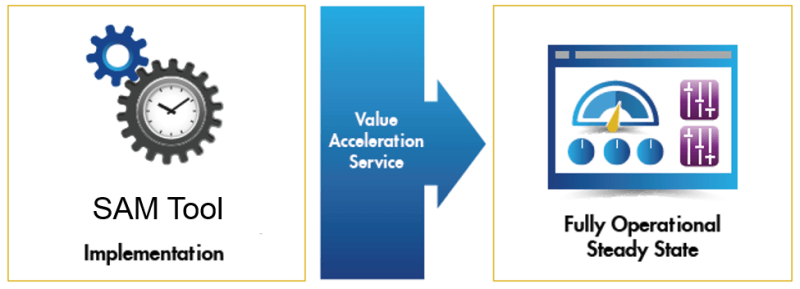The responsibilities for managing a Software Asset Management (SAM) program can vary depending on the organization and there is no easy formula to determine staffing levels required. There is no “one size fits all” approach to determining the right amount of resources. The total number of resources required could be based on total software spend, number of devices (data center and desktops), number of software titles and/or software licenses to manage, along with the amount of business analysis work required to support the enterprise. Before an organization tries to determine the number of resources they need to support a SAM program, its best to understand the basic daily functions of any SAM tool and where the SAM team sits in the organization.
In some organizations, the SAM team resides within the IT organization and this allows for close alignment with core sources of information like discovery and inventory data, as well as hardware asset management, configuration management and service management processes. This also facilitates involvement in operational activities like problem/incident/change management that impact SAM processes and activities such as reclamation of licenses for unused applications, monitoring for unauthorized software installations and hardware decommission and disposal.
In other organizations, the SAM team sits in the Finance/Procurement department which allows a close working relationship with the procurement, sourcing and vendor management team. This can aid negotiation of software license agreements that best meet the needs of the business while also being manageable. And it can allow better communication of license entitlements across the organization to maintain license compliance.
There are several activities the SAM team will need to perform to ensure value is realized from the investment made in a software asset management tool. Sources for inventory and business data connected to the SAM tool must be monitored and maintained, new software licenses need to be added, unauthorized software installations must be actioned, the usage of existing applications needs to be monitored to ensure they are being used effectively, and so on. The SAM tool is the hub for everything software and license related. Your software asset management resources will have to develop expert knowledge of the tool and associated SAM processes to ensure the organization gets the most out of its SAM program.
There are 3 functional areas that your core SAM team must manage in order to sustain SAM processes and tools. These are:
1. Systems and Inventory Services
Systems and Inventory Services provides visibility and core monitoring of the deployed hardware and software that are supported by the SAM tool. System and Inventory Services are the technical tasks performed by the SAM tool administrator such as:
- Systems monitoring and health management
- System upgrades
- Discovery and Inventory management, potentially including the full software stack (operating systems, virtualization, databases, middleware, and enterprise applications)
- Inventory and Business import/interface maintenance—this includes the connectors that allow collection and import of license entitlements and contract information
These services provide the infrastructural foundation for the SAM tool to enable a healthy and stable environment so the other 2 functional services areas can be effective.
2. SAM Operations Services
Once data is imported into the SAM tool, such data needs to be processed to provide actionable insight and information to the business. The SAM Operations Services are the operational tasks performed by the tool operators such as:
- Software Asset Lifecycle Management
- Application Management
- Processing of Purchase Orders to Sustain License Positions
- Providing Reporting and Collect Metrics
- Data Quality Support of Inventory and Business Data
SAM Operations Services provide operational support for the data within the SAM tool so License Compliance and Optimization Services can be completed.
3. License Compliance and Optimization Services
License Compliance Services deliver a ‘software purchased to software inventory’ level of reporting based on the collected entitlement data reconciled with installations. License Optimization Services ensure product use rights are applied to optimize license consumption for applications based on contractual agreements. The use rights include upgrade, downgrade, right of second use, multiple use, and roaming use, among others. The resources supporting License Compliance and Optimization Services are responsible for:
IT Asset Management
It all starts with knowing what’s in your IT ecosystem. Flexera One discovers even the most elusive assets whether on-prem, SaaS, cloud, containers and more.
- Providing subject matter expert knowledge for key publishers’ license terms and conditions
- Identifying instances of material license compliance risk
- Quantifying the extent of non-compliance in dollar ($) value, to drive awareness, facilitate priority setting and focus remediation efforts based on total risk.
- Working with the appropriate organizations to review the license optimization recommendations and determining which are achievable.
- Identifying areas where license reclamation may be possible and implementing an automated reclamation process
- Identifying areas of potential cost savings as reported by the SAM tool and taking action to realize those savings
Understanding the core functions of the SAM tool and the skills needed to perform these functions are paramount to determining the resource requirements.
As the SAM program progresses, the evolution of the organization should move from strictly operational to one that supports business analysis for the effective and efficient management of IT. The resources and skill sets in the organization will need to evolve along with those capabilities.

Many companies looking for a SAM tool do not have a dedicated team in place to effectively manage their software estate with the new tool. Far too often, organizations have considerable setbacks or are slow to demonstrate the expected value after the SAM tool has been implemented and need help implementing best practice SAM processes in conjunction with the tool to meet their business goals and objectives. Companies should look to their SAM tool provider to help fill the gap from the end of the tool implementation to when the organization is prepared to fully take over the operation of the SAM program. The benefit is a sustainable solution that avoids set-backs and accelerates business value realization.





